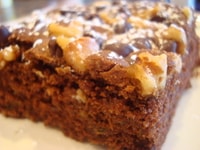Lemon Opera Cake


But I am getting ahead of myself. This month's Daring Baker's challenge, my third, was the famous French dessert, Opera Cake. I was thrilled with this selection, as this recipe has been patiently sitting in my Epicurious Recipe Box for years now, and I have simply needed a reason to make it. While the challenge version hails from a different source, based on Dorie Greenspan's Paris Sweets rendition, I would still be able to check it off my baking bucket list after completion.
Very little is known about the genesis of L'Opera, as it is called in France. Its creation is credited to 
The recipe, as the Daring Bakers prepared it, can be found in full on fellow DB Ivonne's Cream Puffs in Venice site. We were tasked with creating a version that only used lighter colors, no dark chocolates, coffees, or cocoas in the buttercream, mousse, and glaze. This is where the Limoncello
For as complex as this recipe looks, I was pleasantly surprised to discover that it wasn't all that difficult, just long. I broke it up into sections, making the syrup and buttercream one day, the joconde the next, and assembling with the glaze last night. I actually cut the recipe in half to make a rectangular cake, and it worked very well. The joconde baked very quickly, about 7 minutes, and the buttercream, which I couldn't stop sampling, came together beautifully, with none of the curdling that I usually experience with true buttercream recipes. I look forward to preparing this again, perhaps with a different flavor profile, for a special occasion or dinner party. It's that kind of dessert. And the Limoncello? Well, it's back in its original spot, waiting to inspire another recipe. Here are some of my tips for making a standing ovation-worthy Opera cake:
- Because there are so many components to this recipe (joconde, buttercream, simple syrup,
optional mousse, and glaze), it is very important to pace yourself and allow plenty of time to create your masterpiece. Everything but the glaze can be prepared at least one day in advance, so dividing the recipe into portions will make the process much easier.
- For the buttercream, one set of directions said to heat the sugar syrup to 225F degrees, while the other (in the cookbook) said 255F degrees. I picked a temperature in the middle, 235F, and the buttercream turned out beautifully. I imagine that either end of the spectrum would have worked just as well, as long as the sugar granules are thoroughly dissolved and the syrup is hot to the touch.
- If you have not made real buttercream prior to this recipe, do not be alarmed if the mixture
appears to look curdled after you have added all of the butter. Continue to mix at medium-high speed, and the buttercream will eventually come together and achieve a satiny smooth texture.
- This recipe can be easily halved, but I recommend making the buttercream as directed, in the event that you need more. Buttercream can be frozen for up to a month, so if you have extra, you can just save it for another recipe.
- The joconde recipe calls for eggs and egg whites at room temperature. To quickly bring eggs up to temperature, simply submerge them in warm water for a few minutes. Room temperature eggs are easier to aerate and result in a fluffier product/








How lovely!!
Your Opera cake came out beautiful! You have a great blog.
Maria
x
Great job on your challenge! By the way, I absolutely love the title of your blog, it's soooo cute 🙂
Limoncello... what a wonderful inspiration for a sunny springtime confection. Great job with May's challenge!
Sounds wonderful - and the decorations are perfect!
Limoncello, my favorite! Great job!
What a great idea to use limoncello! I love that you used coconut. With the almonds, that's almost like an Almond Joy!
Love your presentation and the colours.
Julie..wow, beautiful decor on this cake! The "limoncino" flavoring sounds divine!!
fantastic!! I love your cakes, they're beautiful!
I LOVE your blog. I found it through the Daring Bakers Challenges on other food blogs. Bravo on the Opera cake. It was stunning and the recipe looks....wow! I hope I can link back to your blog, from my silly little blog. I am going to join for the next month's challenge, wish me luck.
Yours came out so pretty! Congrats on a job well done. What a great cake for spring.
That looks so good! I'm finishing mine this afternoon and hope it can look that yummy.
So pretty! Love the colors...looks really yummy!
Limoncello - that is an ah ha moment! Brilliant! Perfect cake!